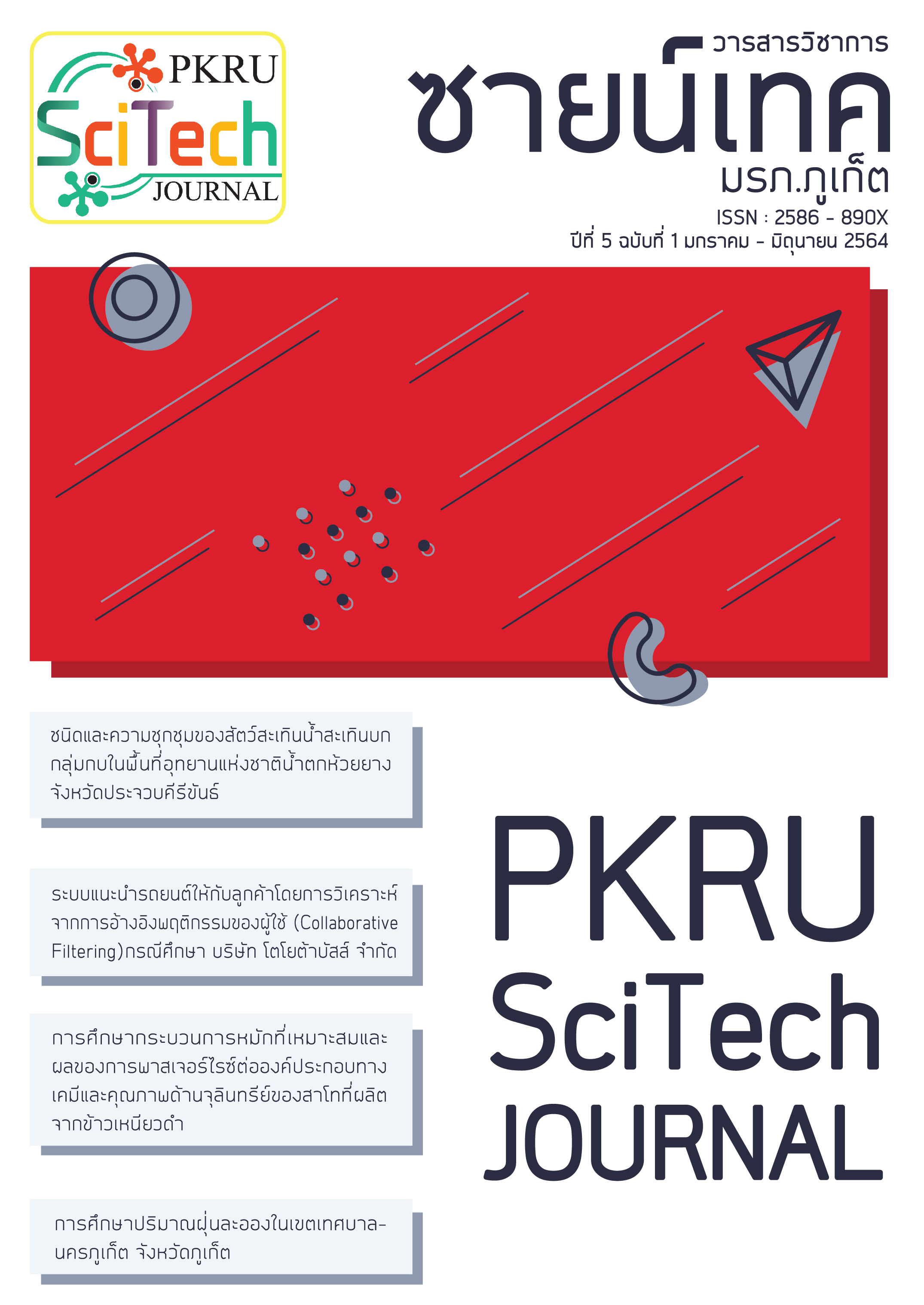The Study of Fermentation and the Effect of the Pasteurization on Chemical Compositions and Microbial Quality of Rice Wine Brewed from Black Sticky Rice
Main Article Content
Abstract
Black rice wine (BRW) is a product that has a similar color to rosé wine due to the containing of anthocyanins. The brewing of BRW likely uses potassium metabisulfite (KMS) for disinfectant agent. However, this process has disadvantage for consumers who have sulfur allergy. Therefore, this research studied the application of the pasteurization instead of the using of KMS for fermentation cessation. The BRW samples were analyzed for the chemical compositions and microbial quality. The BRW brewing was started at the saccharification using Aspergillus oryzae ATCC 22787 at 30°C for 2 days, and then followed by the fermentation using Saccharomyces cerevisiae NCYC 478 at 25°C for 6 days. The BRW was pasteurized at 70°C for 15 min. After that, they were analyzed for chemical compositions. The results showed that volatile organic acids (propionic acid and acetic acid), maltose and cyanidin 3-glucoside in pasteurized BRW were significantly decreased (p<0.05) comparing to non-pasteurization BWR. However, glucose was increased and the alcohol in pasteurized BRW was not significantly different (p≥0.05) with non-pasteurization BRW. Furthermore, the study of microbial quality showed that the pasteurization stopped the growth of microorganisms in BRW.
Article Details
- The original content that appears in this journal is the responsibility of the author excluding any typographical errors.
- The copyright of manuscripts that published in PKRU SciTech Journal is owned by PKRU SciTech Journal.
References
Wachira, S. (2015). The production of red wine from black jasmine rice. Journal of Food Research, 4(6), 69-81.
Yotmanee, S. (2018). Identification of the characteristic taste, aroma compounds and the corresponding precursors in pigmented rice wine. PhD Thesis. UK: University of Reading.
Yodmanee, S., Karrila, T. T., & Pakdeechanuan, P. (2011). Physical, chemical and antioxidant properties of pigmented rice grown in Southern Thailand. International Food Research Journal, 18(3), 901-906.
อภิชญา เตชะวสัญญู. (2550). การแยกจำแนกและลักษณะสมบัติของยีสต์และราในลูกแป้งสุราเพื่อการผลิตสาโท. วิทยานิพนธ์ ปริญญาวิทยาศาสตรมหาบัณฑิต. กรุงเทพ: จุฬาลงกรณ์มหาวิทยาลัย.
พกนิษฐ์ พ่วงวีระกุล, และชลมารค พ่วงวีระกุล. (2547). การประกันคุณภาพสาโท. รายงานการวิจัย. กรุงเทพ: กรมโรงงานอุตสาหกรรม กระทรวงอุตสาหกรรม.
Chuchat, K., Wichai, S., & Varavut, T. (2016). Study on production of Sato from indigenous rice varieties in Nakhon Ratchasima. In The National and International Graduate Research Conference 2016. Khon Kaen University.
Wüthrich, B. (2018). Allergic and intolerance reactions to wine. Allergologie select, 2(1), 80–88.
อรอง จันทร์ประสาทสุข. (2562). การคัดแยกและจำแนกจุลินทรีย์จากลูกแป้งเป็นกล้าเชื้อสำหรับการผลิตผลิตภัณฑ์ข้าวหมัก. รายงานการวิจัย. มหาวิทยาลัยบูรพา.
Techakanon, C., & Sirimuangmoon, C. (2020). The effect of pasteurization and shelf life on the physicochemical, microbiological, antioxidant, and sensory properties of rose apple cider during cold storage. Beverages, 6(3), 1-18.
Zappa, G., Conterno, L., & Gerbi, V. 2001. Determination of organic acids, sugars, diacetyl and acetoin in cheese by high-performance liquid chromatography. Journal of agricultural and food chemistry, 49(6), 2722-2726.
Seal, T. (2016). Quantitative HPLC analysis of phenolic acids, flavonoids and ascorbic acid in four different solvent extracts of two wild edible leaves, Sonchus arvensis and Oenanthe linearis of North-Eastern region in India. Journal of Applied Phamaceutical Science, 6(2), 157-166.
ปิยมาศ แจ่มศรี, และขวัญมิตร รู้จัก. (2560). การทวนสอบอาหารเลี้ยงเชื้อชนิดแข็ง Plate count agar (PCA) และ Reasoner’s 2A (R2A) agar สำหรับการตรวจวิเคราะห์จำนวนจุลินทรีย์ทั้งหมดในน้ำและน้ำแข็ง. วารสารกรมวิทยาศาสตร์การแพทย์, 59(4), 242-251.
Capece, A., Romaniello, R., Siesto, G., & Romano, P. (2018). Conventional and non-conventional yeasts in beer production. Fermentation, 4(38), 1-11.
Park, K. M., Seo, J. A., & Kim, Y. S. (2019). Comparative study on metabolic changes of Aspergillus oryzae isolated from fermented foods according to culture conditions. International Journal of Food Microbiology, 307, 1-9.
Dalawai, N., Krupa, K. N., Nadkarni, S., Bharani, S., & Harinikumar, K. M. (2017). Screening of efficient ethanol tolerant yeast strain for production of ethanol. International journal of pure and applied bioscience, 5 (1), 744-752.
Liu, D., Zhang, H. T., Xiong, W., Hu, J., Xu, B., Lin, C. C., Xu, L., & Jiang, L. (2014). Effect of temperature on Chinese rice wine brewing with high concentration presteamed whole sticky rice. BioMed Research International, 1-8.
Kong, C. T., Ho, C. W., Ling, J. W. A., Lazim, A., Fazry, S., & Lim, S. J. (2018). Chemical changes and optimisation of acetous fermentation time and mother of vinegar concentration in the production of vinegar-like fermented papaya beverage. Sains Malaysiana, 47(9), 2017–2026.
Odriozola-Serrano, I., Soliva-Fortuny, R., & Martín-Belloso, O. (2008). Phenolic acids, flavonoids, vitamin C and antioxidant capacity of strawberry juices processed by high-intensity pulsed electric fields or heat treatments. European Food Research and Technology, 228, 239-248.


